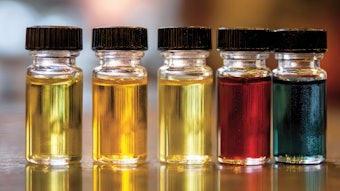In the usual processes of water-steam or hydrodistillation, or even in the process of preparing the cold-pressed essential oils, the oil comes into a close and prolonged contact with water. It can be said that all distillation processes yield an essential oil in two fractions; the first is the fraction that is insoluble in water and is decanted off from the separator in a traditional manner, and the second is the water soluble fraction which remains in the distillation water and is usually discarded with the water. We will refer to these as the “decanted fraction” and the “water soluble fraction” in this paper. This contact results in a portion of the essential oil being dispersed and carried away by the aqueous effluent. How seriously this phenomenon effects the yield of the essential oils can he seen from Table 1.
Unfortunately, the problem of water contact does not just cause a diminished yield of the oil. The volubility of low flavor and odor value terpene and sesquiterpene hydrocarbons is negligible (being at the ppm level at best); however, the solubilityof desirable oxygen-containing components, such as, esters, ketones, aldehydes, alcohols, phenols, etc., often reaches levels of 0.05-1.0%.
In essential oil production, the amount of steam required for oil recovery is normally comparable to the weight of the plant material. Since commercial essential oil-bearing botanical usually yield between 0.1% and 1.0% of the oil, the amount of aqueous effluent exceeds that of recovered oil by a hundredfold or more. Due to the different solubilities, various essential oil components are disproportionately postitioned into the aqueous phase and, hence, the variable polar components are either reduced or lost. Because of this phenomenon, relatively soluble minor components of the oil can escape completely resulting in an unbalanced odor and flavor profile when compared with that of the original plant. Therefore, the water soluble fraction is of importance to both the quantitative and qualitative outcome of the essential oil production.










